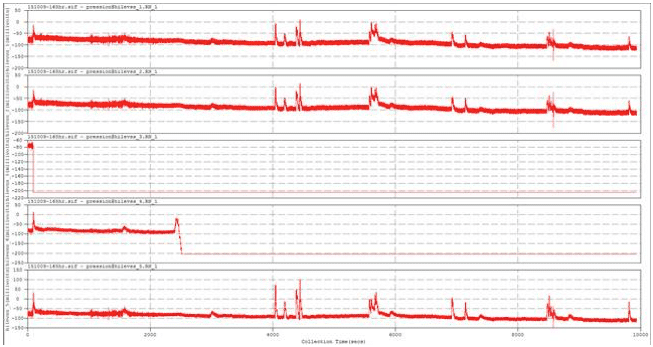ASTM B117 Test – Real world application

ASTM B117 Test – A real life example of corrosion testing
We mentioned in a previous article that ASTM B117 Test is used to evaluate how different types of metals corrode under simulated real-life climatic conditions on a highly accelerated basis.
Over the years, Micom Laboratories has developed a reputation as a trusted go-to material testing lab. Our clients know that we thoroughly test their products and we carefully follow the best practices and testing guidelines.
In this article we want to demonstrate a real life example of how ASTM B117 Corrosion Testing Protocol can be used to determine the quality of products as well as help businesses make better purchasing decisions based on facts and real results.
One of our customers was considering purchasing a set of microphones for various outdoor applications (ex: outdoor concerts, events, etc.,) and it wanted to make sure the microphones would perform well during outside events regardless of different weather conditions.
Previously the client had mixed results with different microphone vendors because some branded microphones developed rust and became unusable after a short use. In addition, some vendors were not always honoring the warranties on the microphones following rust buildup.
Among five different suppliers, the client wanted to determine which microphone would show the best corrosion resistance for outdoor applications.
Below we show how we designed a comparative evaluation experiment based on standardized ASTM B117 test methods.
Microphone basics
How do microphones work? Microphones convert surrounding sounds into an electrical signal that becomes an audio signal.
Why would a microphone stop working properly during outdoor events? When a person uses a microphone, she generally speaks into it in close proximity. As the person exhales towards the microphone, moisture from the person’s breath enters the microphone. In addition, as the person moves, the ambient moisture from the air enters the microphone. Overtime, this moisture can cause the metal elements inside the microphone to corrode and stop working.
Generally, microphone manufacturers tend to build their products for general use and not tailor them for specific geographic locations or environmental conditions. For example, once a user purchases a microphone she can use it in different environments such as colder, warmer, drier or more humid locations. If the microphone is used in costal areas, salt moisture from the air will affect the metals components differently than if the microphone is used closer to fresh water.
Microphone corrosion test parameters
Since microphones will be affected differently by corrosion in various environments, we need to reproduce this metal degradation problem on a comparative yet accelerated basis.
To test which of the five microphones shows the most resistance to corrosion, we need to create the following setup:
- Create a constant noise source to simultaneously excite the five microphones
- Have a controlled and more corrosive atmosphere than normal ambient air
- Record the audio signals generated by the five microphones
It is important to note, that to make sure we compare “apples to apples” we need to test the five microphones at the same time. Using the same noise source, we excite the microphones and measure their response signals concurrently.
For this test, we used a power supply to energize the five microphones and a data logger to measure their audio output signals for one second at one minute intervals using a sampling rate of 2500 times per second.
Observations from accelerated aging tests and corrosion tests are often recorded on an incremental basis during the duration of the test. However, observations can also be recorded at the end of the test. In addition, based on the test specifications, we can record dynamic measurements while the aging is occurring.
ASTM B117 Test
Micom Laboratories tests accelerated corrosion using the ASTM B117 Test as well as the ASTM G85 Test under the Standard Practice for Operating Salt Spray (Fog) Apparatus Guidelines. These guidelines provide a framework to properly create a controlled environment that will be used to evaluate the relative corrosion resistance of metals and various coated metals specimens.
Originally introduced in 1939, the ASTM B117 Test continues to be widely used across numerous industries that need to prevent corrosion such as defense, aerospace and many consumer related industries. Manufacturers need to understand how metal degradation will affect the quality and behavior of their products.
The Salt Spray (Fog) Apparatus atomizes a salt solution at a constant rate using nebulizers. Using the Salt Spray Test provides us with a constant, controlled, and accelerated corrosion process for getting our five microphones to “rust”. In addition to being able to control corrosion conditions inside the chamber, we can generate a constant sound signal to excite all five microphones simultaneously in order to determine which microphone performs best and shows the least amount of corrosion under different simulated outdoor conditions.
We can see from the chart below that after undergoing corrosion testing in our Salt Spray (Fog) Apparatus, microphone three (the third line from the bottom) stopped working after only a few hours of exposure. Microphone two (the second line from the bottom) lasted about 42 hours whereas microphones one, four and five (the first, fourth and fifth lines respectively from the bottom) lasted until the end of the 165 hours of exposure.

We hope you found this article about corrosion testing valuable. Micom is a third party material testing laboratory accredited by A2LA, CGSB and ISTA. We invite you to contact us to learn more about how we can help your organization better test for corrosion impact on your products under the ASTM B117 Test guidelines.
If you like to get a PDF version of this article, please view the presentation below
This article is a preview of the Corrosion Testing white paper that we are currently working on and that will be available in the following months. If you would like to be notified when our white paper on corrosion comes out, we invite you to send us an email.
Disclaimer
All of the information and opinions contained in this blog are made with the information, and the understanding that we have reviewed at the time of publishing. However, despite our efforts, we do not offer any guarantee of their accuracy, thoroughness of our investigation or validity. The author of this blog is not liable for any inaccuracies or any losses or damages that may result from the use of the information or data contained herein. This blog has not been reviewed or verified for its accuracy by any peer group associates prior to publication.


